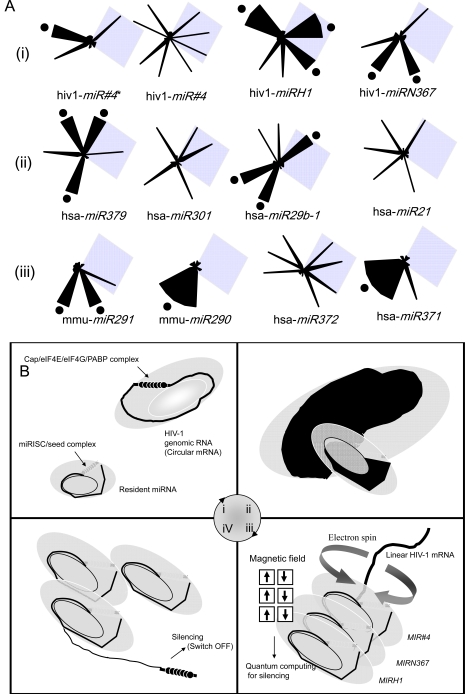Fig. (4).
A model of tanslational tuning by virally mobile miRNAs. (A) G-G repeats in the miRNAs. The viral miRNAs of HIV-1 (i), self-renewal-related miRNAs (ii) and differentiation-related miRNAs (iii) contained GG repeats (black dots). The calculated FMO values were represented as a radar-circle, which could be represented as wings by Excel software (Microsoft corp.). Shaded diamonds are represented as the region of the seed. The FMO values of each atom of bases were calculated by winMOPAC software version 3 (SCIGRESS MO Compact Professional: Fujitsu Corp. Tokyo, Japan) and each panel was illustrated by EXCEL (Microsoft Corp. USA). (B) Quantum theory of the RNA wave in translational tuning. The model of Fabian et al. in the Sonenberg laboratory (2009) is modified and the modified model is represented. (i) Circularized viral HIV-1 RNA (mRNA) via eIF4G-PAGP interaction and viral miRNAs, such as MIR#4, MIRN367 and MIRH1 are circularized via Ago2 and GW182. (ii) miRNA targets mRNA. Black shaded regions represented appropriate mage of unbalanced electron distribution. (iii) Circularized mRNA by cap-binding factor eIF4E plus eIF4G and poly(A)-binding protein PABP could make miRISC into linear strand of mRNA. miRISC is the link of the miRNA ring and circularized miRNAs are superposed. Electrons on the virally circular miRNAs would move from one base to another neighboring base, whereas electrons may spin round. Depended on the direction of the rotating electron, the direction of the magnetic field would go up or down. The superposing of the magnetic direction of electrons according to quantum theory may be the code of RNA as in quantum computing (Fujii, 2008). (iv) The mobile miRNAs can tune silencing ON (Switch ON) and repeat to (i) ~ (iv) in very short time (see Movie S1).

